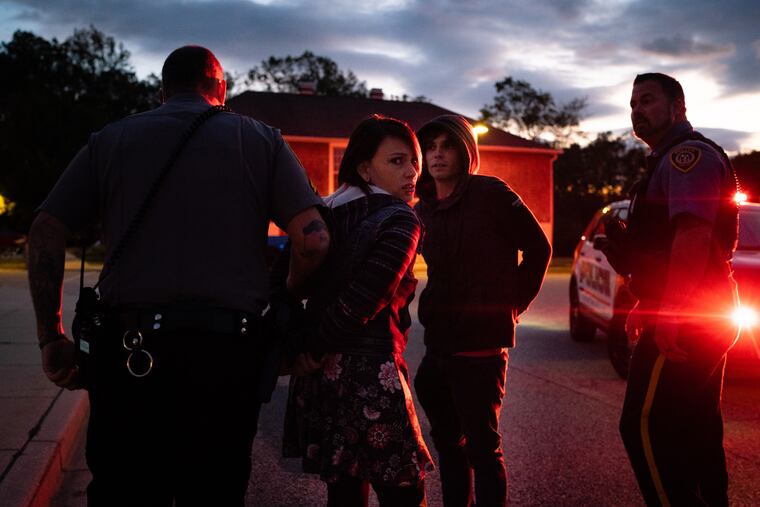This Maryland town turned its opioid nightmare into a haunted house. And it’s terrifying.
The people of Centrevill, Md., have created a huge haunted house. Only, rather than witches and mummies, it's a tableau of the nightmare the entire county is enduring - a journey through drug addiction.

CENTREVILLE, Md. - This beautiful county - a place of farmers and watermen, colonial history and Greek revival architecture along the Corsica River - is haunted by addiction.
Queen Anne's County on Maryland's Eastern Shore has one of the nastiest rates of opioid overdoses and deaths in the nation. While this epidemic is slowly ebbing across the country, it's soaring here.
And that scared Eric Johnson, 43, as he returned to his hometown to raise his family after spending years away in big cities.
"We have a serious problem here," said Johnson, the county's emergency management director who has lost four family members to addiction. "And we knew we had to do something about it."
So he and some of the other townspeople decided to capitalize on that fear this Halloween. They have created a huge haunted house. Only, rather than witches and mummies, it's a tableau of the nightmare the entire county is enduring - a journey through drug addiction.
I went to one of their planning meetings on a hot, August evening, in a country classroom.
Residents stood up to introduce themselves and what they were doing for the haunted house: costumes, refreshments, construction, decorations.
Each of them - from string-bean kids in baseball caps to schoolteachers in sensible shoes - explained their connection to drug addiction.
"It got my favorite uncle. It was a really hard loss," said the baseball cap kid.
"I've had to bury friends younger than me and friends older than me," said a musician.
"I lost my brother-in-law last year," said a sports dad.
"I heard the middle-schoolers on our bus talking about how good the heroin is," said one of the teachers. "Middle-schoolers."
Nearly all of them knew someone.
It's not just the 122 people who overdosed last year - 16 of them fatally - that frightens folks here. It's the shocking increase, said Maggie Thomas, who tracks the numbers as director of the county's Addiction and Prevention Services.
The haunted house at the Kennard African American Cultural Heritage Center will have scenes from a drug den, a frightening arrest, a court hearing, a jail cell, a wrenching family crisis, a harrowing overdose. They will go into the dark and dirty details of shooting heroin and fentanyl. It's a walking, shrieking, living, screaming PSA.
They're calling it the Haunted Trap House - an update of their 1989 Haunted Crack House in the county's old jail.
"Dare to experience the chilling story of a girl who gets tangled in the web of addiction," the posters from that period said.
Never mind that the police chief back then told The Washington Post he remembered just one arrest for crack cocaine in his jurisdiction.
This time, the town is ground zero for the drug crisis and in a state that is still battling record opioid fatalities.
Just a few months after planning began, a woman was arrested for allegedly selling heroin yards away from the haunted house site.
Thirty years ago, Johnson was a 13-year-old kid who played a character in one of the addiction scenes.
He thought about that as he watched his brother-in-law die of a heroin overdose last year and as he saw his county colleagues respond to call after call for overdoses.
"In one of our most recent overdoses, the guy still had the needle in his arm when the woman with him called 911 to say he OD'd. Then, she took the needle out of his arm and put it in hers because, she told responders, 'it was some good s---,' " Johnson said.
Dozens of people showed up to help with the haunted house. There is a local carpenter who's tired of reading about all the opioid deaths. There is a drama teacher who has been coaxing the most convincing overdoses out of her volunteers for weeks. There are costume designers, event planners, real police officers who will stage arrests, a real judge to hand down a sentence. They even have real prisoners, who are encouraged to interact with the visitors. It won't be pretty.
Republican Gov. Larry Hogan, who declared a state of emergency over the opioid crisis in Maryland two years ago, is planning to walk through the haunted house this week, Johnson said. He even got a "maybe" from first lady Melania Trump's office.
Once visitors go through the gut-punch that is an addict's life, they'll have the treats, yes, but they will also have counselors on site for anyone who may be moved to seek help.
“If we can help one person, just one person stops using or doesn’t start using because of this,” Johnson said, “it’s all worth it.”